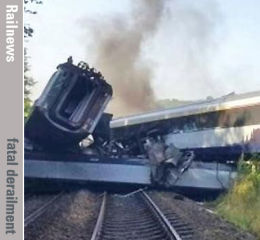Posted 14th August 2020 | 4 Comments
Stonehaven update: HST was returning to Aberdeen when it hit landslip

THE ScotRail train which was derailed south west of Stonehaven on Wednesday had abandoned its journey to Glasgow Queen Street and was returning to Aberdeen, the Rail Accident Investigation Branch has revealed.
After some contradictory speculation over the past two days, it has now emerged that the 06.38 from Aberdeen was on time. It had already passed the site of the later derailment and was continuing towards Glasgow when the signaller at Carmont warned the driver by radio that a landslip had been reported on the up line ahead of the train, between Carmont and the next station at Laurencekirk.
The train was then reversed on to the down line, using a crossover at Carmont, and started its journey back to Aberdeen.
After travelling for about 2.25km, the train struck a landslip on the down line, which derailed it.
The RAIB continued: ‘As the track curved to the right, the train continued in a roughly straight line for around 90 metres until it struck a section of bridge parapet, which was destroyed. The leading power car continued over the bridge and then fell from the railway down a wooded embankment, as did the third passenger carriage. The first passenger carriage came to rest on its roof, having rotated to be at right angles to the track. The second passenger carriage also overturned on to its roof and came to rest on the first carriage. The fourth passenger carriage remained upright and attached to the rear power car; it also came to rest on the first carriage. All wheelsets of the rear power car derailed, but it remained upright.’
Chief inspector Simon French added: ‘Thankfully, fatal derailments are a rare occurrence on the UK’s national network. However, landslips and other earthworks failures remain a risk to trains that needs to be constantly managed – and this is becoming even more challenging for the rail industry due to the increasing incidence of extreme weather events.
‘We have an expert team at the site of the derailment who are the gathering the evidence that is needed to understand what happened, and why. They share my determination to pursue every line of enquiry, to analyse the evidence, and to identify important safety learning.’
Reader Comments:
Views expressed in submitted comments are that of the author, and not necessarily shared by Railnews.

Matthew Ellis, Woking
There are many miles of embankments on our rail system and many (most?) were built before anyone understood ‘soil mechanics’, so they were literally built with whatever was to hand. The fact that they are still standing is a credit to the builders.
Replacing them all is an unrealistic proposition based on the disruption and huge cost. But we do know that with changing weather patterns, landslips are becoming more frequent (although thankfully thus far few have had the tragic consequences of the Stonehaven ones).
I know that Network Rail is urgently reviewing identified ‘high risk’ embankments, but if this work is anything like the post-Grenfell building cladding review, it will take months or years simply because there are a limited number of professionals qualified to undertake the work.
So (my armchair view) it appears we need some form of (cheap) reliable automated active embankment monitoring to provide an immediate warning of movement - ideally something sensitive enough to show up any movement before it becomes a danger to life. Assuming such a system already exists, even this would take years to design/install with a significant cost.
Sadly, in the short to medium term we need to acknowledge Stonehaven will likely not be an isolated incident.
king arthur, buckley
It would be very interesting to know what speed the train was doing prior to the crash.
Henry Peacock, Preston
There have been a number of confused - and confusing - reports regarding this crash. It now appears that the train journey was stopped by a report of a landslide.
The train was returning to Aberdeen - using the line it had just passed along - when it was derailed by a landslide. This raises as many questions as it answers.
Christopher Jones-Bridger, Buckley
Many thanks to RAIB for releasing this succinct summary of the events of this most tragic accident allowing an understanding of why it was so devastating and distructive. As ever I'm sure that the full RAIB report will be a thorough examination of all aspects relating to the accident.
As the chief inspector notes landslips and other earthwork failures are a risk that requires constant management. In this era of extreme weather events prediction of failure is a very dark art. While Stonehaven has concentracted attention onto the rail industry it is not alone in facing the magnitude of managing these events. This weeks storms have also led to a breach in the Union Canal at Polmont [www.railnews.co.uk/news/2020/08/14-torrential-rain-in-scotland-leaves.html] in turn resulting in the blockage of the Edinburgh to Glasgow railway line. Also the A68 Edinburgh to Borders road has suffered a collapse leading to it being closed. Civil engineers are facing a constant battle to identify and mitigate the risks our changing climate is creating.